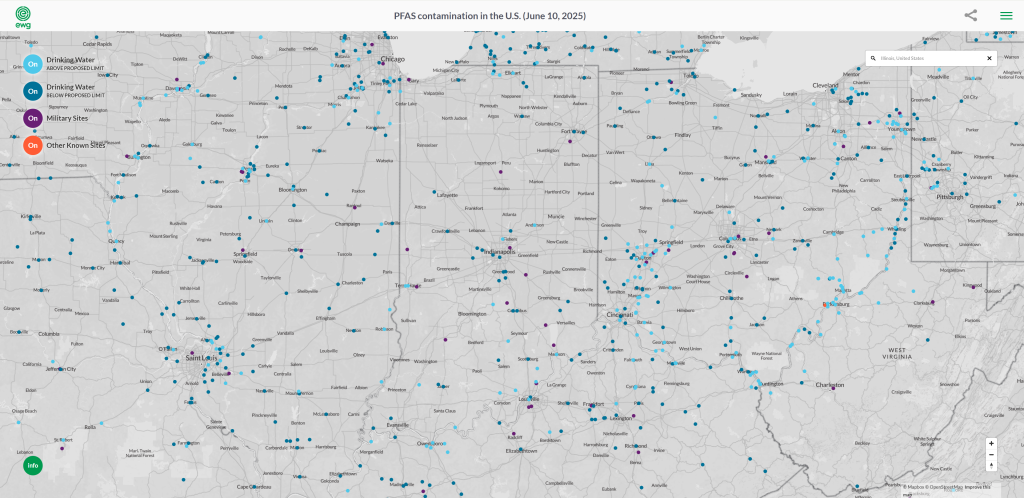- Home
- Personal Injury
- PFAS Lawsuit
- PFAS Contamination Map
- PFAS in Illinois
PFAS in Illinois
- Last updated: July 16, 2025
-
Contributor: nicky

PFAS in Illinois has become a pressing concern, as many communities report contaminated water sources and potential health risks. I have followed data from the Illinois Environmental Protection Agency (IEPA) and other official sources to understand why these chemicals are so persistent, how they affect local populations, and what steps are being taken to mitigate their impact. Over 400,000 residents across at least 47 communities have faced groundwater contamination linked to Per- and Polyfluoroalkyl Substances (PFAS), often called “forever chemicals.” These numbers continue to grow as testing improves.
PFAS water contamination is not unique to Illinois. Similar challenges have been documented in Massachusetts and other states. However, recent action in Illinois showcases how state agencies, lawmakers, and concerned citizens are responding to this issue. In this article, I aim to present the vital information you need if you suspect your drinking water or property may be affected by PFAS.
What are PFAS and why are they dangerous?
PFAS (Per- and Polyfluoroalkyl Substances) refer to a family of man-made chemicals that first entered commercial use in the 1940s. They have strong carbon-fluorine bonds making them resistant to breakdown in natural environments. This stability, while beneficial in products like non-stick cookware or stain-resistant textiles, has led to widespread accumulation in soil, water, and even the human body.
Exposure to PFAS can occur through drinking contaminated water, ingesting affected produce or meat, and contact with consumer goods made using these chemicals. Researchers are still mapping out every possible health effect, but scientists have already linked PFAS exposure to issues with fertility, developmental delays in children, immune system dysfunction, and certain cancers. Because PFAS do not degrade easily, many experts call them “forever chemicals.”
Several PFAS compounds, such as PFOA and PFOS, are no longer produced in the United States. Yet international manufacturing continues, and new variants of PFAS—like HFPO-DA (used in GenX technology)—have entered the market. This makes the regulatory and cleanup process even more complicated for agencies across the country.
Where are PFAS found in Illinois?
PFAS contamination in Illinois has been tracked in multiple ways. According to the IEPA, these chemicals have been detected in both groundwater and surface water near industrial sites, firefighting training facilities, and landfill areas. The contamination also extends beyond industrial zones, seeping into private wells in rural communities.
Some key factors contribute to the presence of PFAS statewide:
- Industrial discharge from manufacturing facilities using PFAS for plating, water-resistant coatings, or chemical production.
- Leakage or runoff from areas where firefighting foam was stored or used, such as airports and military bases.
- Landfills that accept waste containing PFAS-tainted materials.
The state’s geography and hydrology allow for PFAS to migrate through soil into groundwater sources used for irrigation or drinking water. As a result, even regions without heavy industrial operations can experience localized contamination if they lie downstream from a PFAS emission site.
PFAS in Illinois’s drinking water
Illinois relies heavily on groundwater for public water and private wells. When PFAS infiltrate an aquifer or surface water supply, they can pose significant health hazards. Understanding the extent of PFAS in the state’s drinking water helps clarify how individuals, municipalities, and state agencies can respond.
Affected cities, towns, and counties
Nearly 47 communities across Illinois have reportedly found PFAS in their water, affecting more than 400,000 residents. Some of the identified locations where tests showed elevated PFAS levels include Lincoln, Marquette Heights, Rosiclare, and Edwardsville. According to IEPA data, one sample in Lincoln measured PFOA at 5.5 parts per trillion (ppt), which exceeds the newly adopted standard of 4 ppt.
Other towns may also face contamination, as consistent statewide data collection began fairly recently. Public water supplies and private wells alike can be susceptible, depending on their proximity to PFAS sources. People who live in older industrial hubs or near firefighting foam training sites are particularly at risk.
Illinois EPA testing and advisories
In 2021, the IEPA launched a broad testing initiative for PFAS in community water supplies. The agency has also issued several notices to the owners and operators of community water systems where PFAS levels exceeded state guidance. Under the Illinois Environmental Protection Act, these water systems now have five business days to notify customers of any PFAS exceedance once they receive official word from IEPA. This requirement improves transparency and alerts residents to consider precautionary measures, such as installing home filtration systems.
To keep the public informed, the IEPA maintains resources:
- Drinking Water Watch
- PFAS Interactive Dashboard and Map
These platforms offer a way to check local water system test results. While testing focused on public water supplies, results may hint at broader distribution of PFAS in nearby private wells.
Sources of contamination: Industry, firefighting foam, and landfills
Chemicals containing PFAS have been used in numerous industrial processes. Manufacturing plants that utilized water-resistant coatings for textiles, non-stick cookware, and protective layers for electronics often discharged PFAS into local water systems. Civilian and military firefighting operations used PFAS-containing foams, allowing the substances to seep into the soil and, over time, into groundwater.
Landfill leachate also contributes to PFAS contamination. Discarded products like treated fabrics or packaging materials can release these chemicals as they degrade. While PFAS degrade slowly, they do leach into local soils and water, becoming a persistent health concern.
PFAS in Illinois’s soil and agriculture
Because PFAS resist natural breakdown, they can accumulate in soil for years. Farmers who use water from contaminated wells to irrigate fields might inadvertently spread PFAS into crops. According to scientific reviews, PFAS can accumulate in fruits, vegetables, and livestock raised on infected farmland.
Agricultural contamination is less extensively monitored than drinking water, but some national studies indicate that repeated exposure to PFAS-laden water can introduce measurable traces of these chemicals into the food supply. Illinois faces additional complexities if farmland is near industrial zones, airports, or firefighting foam training sites.
While not every plot of farmland is affected, it is crucial for agricultural stakeholders to stay informed. Individual farmers might sample their irrigation sources and test soils if they are near known PFAS contamination sites. If PFAS are detected at unsafe levels, specialized filters or water source changes might help reduce the risk of spreading PFAS through produce or livestock.
Health effects of PFAS exposure
PFAS exposure has been associated with several notable health risks. According to multiple scientific studies, these risks vary based on the specific PFAS chemical, concentration levels, and exposure duration. Common health concerns include:
- Changes in liver function and elevated cholesterol
- Effects on fetal and maternal health, including high blood pressure in pregnant women
- Immune system suppression and reduced vaccine response
- Possible developmental delays in infants and children
Long-term, more severe possible impacts include cancer, specifically kidney and testicular cancers, which researchers have tied to PFOA. PFOS has also been linked to certain thyroid diseases and other endocrine disorders. Individuals who suspect PFAS exposure should consult healthcare professionals and consider regular medical checkups to screen for these conditions.
PFAS-linked diseases in Illinois
Data gathered by health agencies suggests that high PFAS concentrations correlate with certain illnesses. While not every individual exposed to these substances will develop disease, the documented connections are concerning. I have read studies that highlight an increased risk of kidney and testicular cancer in populations exposed to higher levels of PFAS. Other conditions, such as thyroid issues and metabolic changes, also warrant attention.
Kidney cancer
PFOA, a well-known PFAS compound, has been consistently linked to elevated kidney cancer risks. According to peer-reviewed studies, the risk increases with higher exposures. Illinois residents who rely on water systems testing above the new 4 ppt standard might want to speak with medical professionals about kidney health and potential symptoms.
Testicular cancer
Testicular cancer has also appeared in research related to PFOA exposure. Firefighting foam, industrial discharge, and landfill runoff have all introduced PFOA into aquifers, affecting men across an array of age groups. In Illinois, where industrial zones overlap with residential communities, the risk may be significant if protective measures are not in place.
Thyroid disease
PFOS, another common PFAS, can interfere with the thyroid gland, potentially leading to hypothyroidism or hyperthyroidism. Scientists say more research is needed, but patterns have emerged noting hormonal disruption. Illinois residents who have experienced unexpected thyroid changes, especially those living in regions with confirmed PFAS exceedances, might consider discussing PFAS exposure with an endocrinologist.
Liver damage and cholesterol changes
PFAS have been tied to altered liver enzymes, elevated cholesterol, and other metabolic disruptions. While direct pathways are still under study, enough epidemiological evidence has led the IEPA and other agencies to adopt stricter guidelines. Long-term exposure, even to relatively low levels of PFAS, may produce cumulative liver stress.
How Illinois is responding to the PFAS crisis
In 2025, Illinois adopted new health-based groundwater quality standards for six PFAS, including PFOA, PFOS, and HFPO-DA. These standards represent the state’s latest response to an evolving public health challenge. Local leaders, state agencies, and water system operators must now collaborate to contain the spread of PFAS and address existing contamination.
Illinois Environmental Protection Agency (IEPA) actions
The IEPA oversees water sampling, data analysis, and public advisories. Between 2021 and 2024, the agency issued seven PFAS Health Advisories to municipal water systems, highlighting contamination concerns. In addition, the IEPA calculates health-based guidance levels (HBGLs) that represent the concentrations at which no adverse health effects are expected to occur.
When a community water system surpasses a stipulated PFAS threshold, IEPA notifies system owners and operators. By law, those owners or operators then have five business days to alert their customers and must offer proof to IEPA that the notices went out. These rules aim to protect consumers by ensuring prompt transparency.
New state guidelines for PFAS in drinking water
As of 2025, Illinois enforces the following groundwater standards for six PFAS compounds:
PFAS compound | Groundwater standard (ppt) |
|---|---|
PFOA | 4 |
PFOS | 4 |
HFPO-DA | 10 |
PFNA | 10 |
PFBS | 2000 |
PFHxS | 10 |
Exceedances may trigger additional sampling, notices to local officials, and remediation plans. Water utilities that exceed one or more of these limits must develop strategies, such as:
- Upgrading treatment processes to include activated carbon or reverse osmosis
- Switching to alternate water sources if available
- Monitoring and retesting at specified intervals
The deadline for infrastructure upgrades or changes is April 2029, though many communities are pursuing fixes sooner to reduce health risks.
Ongoing site investigations and remediation projects
Several Illinois communities have begun examining their water supplies and possible PFAS hotspots. In some cases, private firms are working with local authorities to fund or implement water treatment solutions. Sites where PFAS exceed standards may also face government scrutiny, leading to civil lawsuits or enforcement actions.
Illinois shares a national pattern of PFAS investigations. Elsewhere, the U.S. Army is remediating PFAS at Fort Devens-Sudbury in Massachusetts, and Delaware investigations have been ongoing at Dover Air Force Base. Similar investigations are active around the country, suggesting that Illinois’s challenges are part of a broader national effort to address “forever chemicals.”
Can you test your water or soil for PFAS in Illinois?
Yes. If you live in a community where PFAS have already been detected, or near industrial facilities linked to PFAS use, consider testing your water or soil. Private testing labs often provide accurate measurements of PFAS levels in samples. The Illinois Department of Public Health (IDPH) can help coordinate with certified laboratories, interpret test results, and recommend treatment options.
In-home treatment methods like point-of-use reverse osmosis and activated carbon filters can reduce PFAS levels in drinking water. These treatments may be installed at specific faucets or at the point of entry to the home. Always look for technology certified by the National Sanitation Foundation (NSF) and follow the manufacturer’s maintenance instructions to ensure continued effectiveness.
You may also want to keep an eye on the IEPA’s publicly available data for community systems near you. While the state does not routinely sample private wells, results from nearby water systems can give a rough indication of PFAS activity in your region.
Do you qualify for a PFAS lawsuit in Illinois?
Litigation around PFAS contamination is growing. As of December 2024, Attorneys General in 30 states, including Illinois, have initiated actions against manufacturers of PFAS chemicals over damage to water supplies and other natural resources. If your property or health has been harmed by PFAS, you may be eligible for legal recourse.
Qualifying for a PFAS lawsuit often involves:
- Showing documented PFAS contamination above health advisory levels
- Demonstrating adverse health outcomes or property damage linked to PFAS exposure
- Identifying responsible parties, such as chemical manufacturers or industrial businesses
If you or someone you know has experienced health issues like kidney cancer, testicular cancer, or thyroid disease potentially related to PFAS exposure, you can explore your legal options. Forces shaping PFAS-related lawsuits include state-level enforcement, class actions, and individual personal injury claims. Companies like DuPont and 3M have faced significant legal action for alleged PFAS contamination, and there is potential for more suits targeting other major PFAS producers.
For more details about water contamination cases, visit the Water Contamination Lawsuit resource at Legal Claim Assistant. If DuPont’s involvement matters to you, view the DuPont Lawsuit page for background on major PFAS litigation.
Why choose Legal Claim Assistant
I appreciate how daunting legal processes can be. That is why I recommend visiting Legal Claim Assistant if you believe PFAS exposure has harmed you or your property. Their services connect people to specialized legal professionals experienced in PFAS-related claims. Their team can:
- Evaluate whether your exposure fits the criteria for a PFAS lawsuit
- Help navigate complex scientific evidence and state regulations
- Provide a free case review to assess your situation
When taking on large chemical manufacturers, it is crucial to have experienced advocates on your side. Legal Claim Assistant can streamline the entire process, from reviewing test data to filing the paperwork needed to launch your claim.
Frequently asked questions (FAQ)
PFAS contamination presents complex questions about health, environment, and legal remedies. I have compiled some of the most common queries about PFAS in Illinois, based on official data and resident concerns.
Contamination appears concentrated in areas with industrial histories, firefighting training facilities, or large landfill sites. According to IEPA data, some of the most significant detections took place in Lincoln and other locations where levels exceeded 4 ppt for PFOA and PFOS. However, PFAS can show up in both urban and rural communities, so ongoing testing remains crucial.
Yes. You can hire certified private labs or get in touch with the IDPH for assistance. Community water results are published on IEPA platforms, but private wells need separate sampling. I suggest contacting a laboratory that specializes in PFAS testing and using NSF-certified filtration systems to reduce risk.
The state adopted new groundwater quality standards for six PFAS, mandating that community water systems act if they exceed these limits. Water supply owners and operators must notify residents within five business days upon receiving an official exceedance notice. The IEPA also issues advisories and enforces guidelines for the removal or reduction of PFAS in municipal water systems.
While contamination primarily makes headlines in public water, PFAS can migrate into soil and crops through irrigation. Findings on agricultural contamination are still evolving, but there is evidence from other states showing PFAS uptake in produce and livestock. Farmers relying on contaminated wells might need to explore filtration or alternative water sources to limit possible PFAS absorption by plants or animals.
Leading concerns include elevated cholesterol, potential immune system impacts, and reproductive or developmental harm. Studies also point to higher risks of kidney and testicular cancers, as well as thyroid diseases, particularly for PFOA and PFOS. Any individual who suspects PFAS exposure might consult a physician for screening and professional medical advice.
Potentially, yes. PFAS lawsuits often target chemical manufacturers or businesses responsible for contamination. If tests confirm high PFAS levels in your water or soil, and if you have suffered health or property-related damage, you could be entitled to compensation. You can request a free case review at Legal Claim Assistant to discover your options.
Overview PFAS contamination in the USA
Here you van find the PFAS watercontamination map of the United States. Find, state by state, where water contamination has occurred due to PFAS exposure.
- PFAS in Alabama
- PFAS in Alaska
- PFAS in Arizona
- PFAS in Arkansas
- PFAS in California
- PFAS in Colorado
- PFAS in Connecticut
- PFAS in Delaware
- PFAS in Florida
- PFAS in Georgia
- PFAS in Hawaii
- PFAS in Idaho
- PFAS in Illinois
- PFAS in Indiana
- PFAS in Iowa
- PFAS in Kansas
- PFAS in Kentucky
- PFAS in Louisiana
- PFAS in Maine
- PFAS in Maryland
- PFAS in Massachusetts
- PFAS in Michigan
- PFAS in Minnesota
- PFAS in Mississippi
- PFAS in Missouri
- PFAS in Montana
- PFAS in Nebraska
- PFAS in Nevada
- PFAS in New Hampshire
- PFAS in New Jersey
- PFAS in New Mexico
- PFAS in New York
- PFAS in North Carolina
- PFAS in North Dakota
- PFAS in Ohio
- PFAS in Oklahoma
- PFAS in Oregon
- PFAS in Pennsylvania
- PFAS in Rhode Island
- PFAS in South Carolina
- PFAS in South Dakota
- PFAS in Tennessee
- PFAS in Texas
- PFAS in Utah
- PFAS in Vermont
- PFAS in Virginia
- PFAS in Washington
- PFAS in West Virginia
- PFAS in Wisconsin
- PFAS in Wyoming
Related Article

What Philips CPAP Machines Are Recalled and Why

